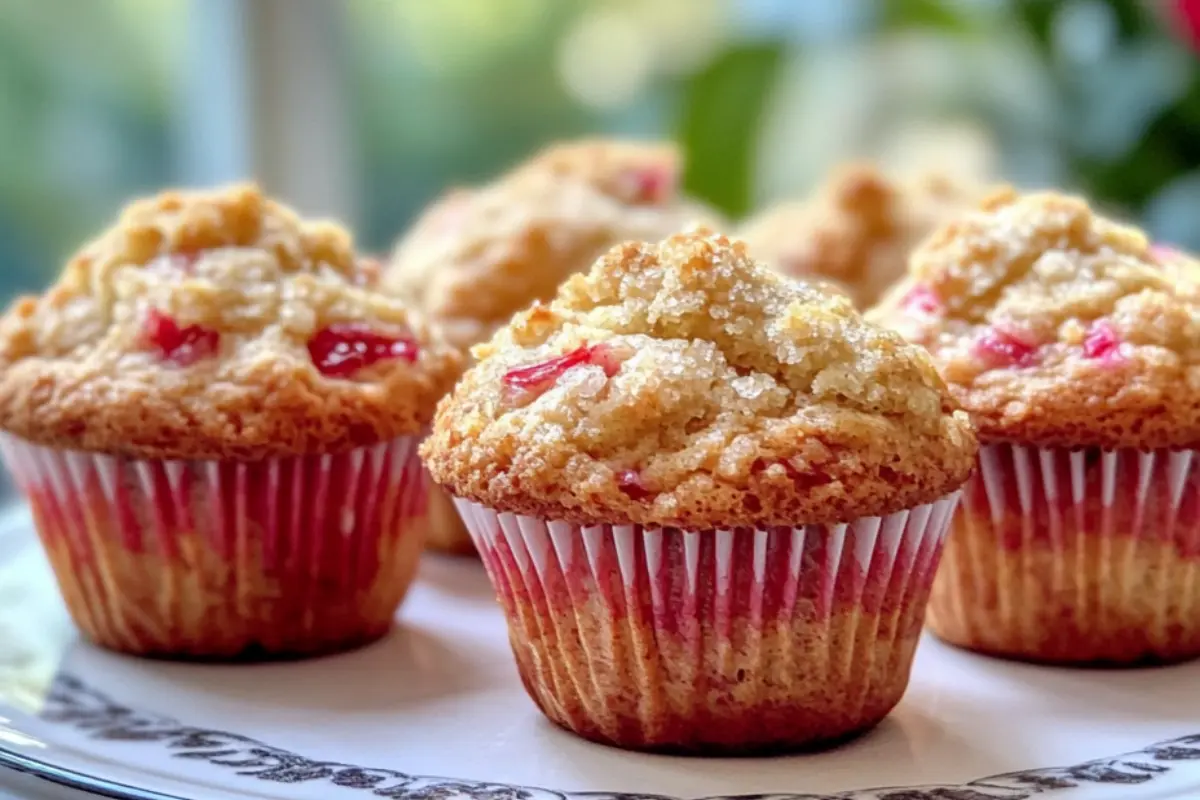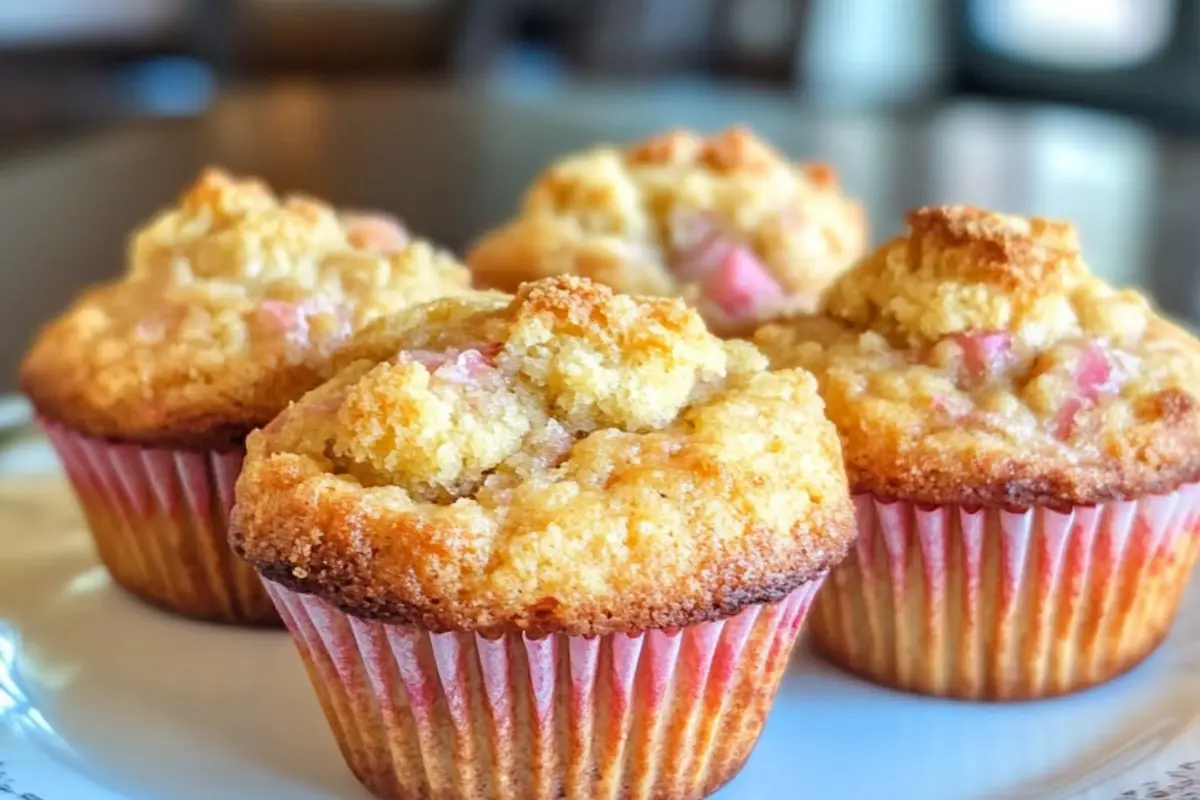There’s nothing quite like biting into a warm, fluffy muffin, especially when it’s bursting with the tangy-sweet flavor of rhubarb. But for those who need to avoid gluten, finding a recipe that’s both delicious and safe can be challenging. That’s where gluten-free rhubarb muffins come into play. These treats are not only gluten-free but also incredibly soft and moist, making them a perfect snack or breakfast option. In this article, we’ll guide you through everything you need to know to make the best gluten-free rhubarb muffins right in your kitchen. From choosing the best flour to tips for achieving that perfect fluffy texture, we’ve got you covered.
What Makes a Good Gluten-Free Muffin?
When it comes to gluten-free baking, the texture can be tricky. Without gluten, it’s easy for baked goods to turn out dense or crumbly. However, with the right ingredients and techniques, you can achieve that tender, fluffy texture everyone loves in a muffin.
The Challenge of Gluten-Free Baking
Gluten is the protein that gives traditional baked goods their structure and elasticity. When you remove gluten, you have to find ways to replicate these qualities using other ingredients. The main challenge in gluten-free baking is achieving a texture that’s light and fluffy rather than dense or dry. This is especially important in muffins, where the goal is a soft crumb and a slightly moist interior.
Why Rhubarb?
Rhubarb, with its vibrant color and tart flavor, is a fantastic addition to muffins. Not only does it add a pop of brightness, but it also provides moisture, which is crucial in gluten-free baking. Rhubarb’s natural acidity also helps balance the sweetness of the muffins, making each bite a perfect blend of flavors.
Essential Ingredients for Gluten-Free Rhubarb Muffins
To create the perfect gluten-free rhubarb muffins, it’s essential to choose the right ingredients. Each component plays a role in ensuring your muffins are both flavorful and have the right texture.
The Best Flour for Gluten-Free Muffins
Choosing the right gluten-free flour is key to achieving the ideal texture. A mix of different gluten-free flours often works best. For instance, a combination of almond flour, rice flour, and tapioca starch can provide a balanced texture. Almond flour adds richness and moisture, while rice flour gives structure, and tapioca starch helps bind everything together. If you prefer a single flour blend, make sure it’s one that’s specifically designed for baking, as these often have the right mix of ingredients.
Other Key Ingredients
Aside from flour, other ingredients play a critical role in your muffins. Xanthan gum or psyllium husk powder helps mimic the elasticity of gluten, giving the muffins their soft and springy texture. Baking powder is essential for lift, and eggs contribute to the structure and moisture. Don’t forget a pinch of salt to enhance the flavors and a touch of vanilla extract for sweetness.
Using Rhubarb in Muffins
Rhubarb can be used fresh or frozen in your muffins. If using fresh rhubarb, make sure to wash it thoroughly and chop it into small, even pieces. For frozen rhubarb, there’s no need to thaw it before adding it to the batter. However, you may want to toss the frozen pieces in a bit of flour to prevent them from sinking to the bottom of the muffins.
How to Make Gluten-Free Rhubarb Muffins
Ready to whip up some delicious gluten-free rhubarb muffins? Here’s a step-by-step guide to help you create these delightful treats from scratch.
Preparation Tips
Before diving into the recipe, it’s essential to prepare your kitchen and ingredients. Start by preheating your oven to 350°F (175°C). Grease a muffin tin or line it with paper liners. This ensures that your muffins won’t stick and will have that nice, crisp edge.
Next, gather all your ingredients. Having everything measured and ready to go will make the process smoother. Make sure your rhubarb is chopped, and your flours are sifted. If you’re using frozen rhubarb, you can toss it lightly in flour to prevent it from sinking to the bottom of the muffins during baking.
Step-by-Step Instructions
- Mix the Dry Ingredients:
In a large bowl, combine your gluten-free flour blend, baking powder, xanthan gum (if your flour blend doesn’t already include it), and a pinch of salt. Stir these dry ingredients together until well combined. - Cream the Wet Ingredients:
In a separate bowl, beat together the sugar and eggs until the mixture is light and fluffy. Add in the vanilla extract and your choice of milk (dairy or non-dairy), and continue mixing until smooth. If you’re using a mixer, start on low speed to prevent splashing. - Combine Wet and Dry Ingredients:
Gradually add the dry ingredients to the wet mixture, mixing just until combined. Be careful not to overmix, as this can lead to dense muffins. The batter should be slightly thick but not too dry. - Fold in the Rhubarb:
Gently fold the chopped rhubarb into the batter. If you’re adding any extras like nuts or spices, this is the time to do so. Ensure the rhubarb is evenly distributed throughout the batter. - Fill the Muffin Tin:
Spoon the batter into the prepared muffin tin, filling each cup about two-thirds full. This allows room for the muffins to rise without overflowing. - Bake:
Place the muffin tin in the preheated oven and bake for 20-25 minutes, or until a toothpick inserted into the center of a muffin comes out clean. The tops should be golden and slightly firm to the touch. - Cool and Serve:
Once baked, remove the muffins from the oven and let them cool in the tin for about 5 minutes. Then transfer them to a wire rack to cool completely. Serve warm, or store for later!
Making the Muffins Fluffy
Achieving fluffy muffins is all about the right technique and ingredients. Here are some tips:
- Don’t Overmix the Batter: Overmixing can activate the xanthan gum too much, leading to a gummy texture. Mix just until the ingredients are combined.
- Use Fresh Baking Powder: Baking powder is what gives the muffins their rise. Make sure yours is fresh and active for the best results.
- Incorporate Air: When creaming the sugar and eggs, beat them until the mixture is light and fluffy. This helps incorporate air, which will make your muffins lighter.
Customizing Your Muffins
One of the best things about baking is that you can get creative and tailor recipes to your taste. Here are some ideas to customize your gluten-free rhubarb muffins and make them your own.
Adding Extra Flavors
If you want to add more depth to your muffins, consider these flavorful add-ins:
- Nuts: Chopped almonds, walnuts, or pecans add a delightful crunch.
- Spices: A pinch of cinnamon or nutmeg can complement the tartness of rhubarb beautifully.
- Fruits: Add in some fresh or dried berries, like blueberries or cranberries, for a fruity twist.
These additions not only enhance the flavor but also add texture, making each bite even more enjoyable.
Using Frozen Rhubarb
Frozen rhubarb is a convenient option, especially when fresh rhubarb isn’t in season. Here’s how to use it effectively:
- No Need to Thaw: You can add frozen rhubarb directly to the batter without thawing. This helps maintain the moisture in the muffins.
- Toss in Flour: To prevent the rhubarb from sinking to the bottom, toss the frozen pieces in a bit of gluten-free flour before folding them into the batter.
- Adjust Baking Time: Since frozen rhubarb adds extra moisture, you may need to bake the muffins for an additional 2-3 minutes. Keep an eye on them and test with a toothpick for doneness.
Storing and Freezing Muffins
To ensure your gluten-free rhubarb muffins stay fresh, here’s how to store them properly:
- Room Temperature: Store the muffins in an airtight container at room temperature for up to 3 days. Adding a piece of paper towel inside the container can help absorb excess moisture and keep them from becoming soggy.
- Freezing: These muffins freeze beautifully! Wrap them individually in plastic wrap and store them in a zip-top bag in the freezer. They’ll keep well for up to 3 months. To enjoy, simply thaw them at room temperature or warm them up in the microwave.
FAQs and Troubleshooting
Baking gluten-free can sometimes be tricky, and you might encounter a few issues along the way. Here, we’ll address some common questions and troubleshooting tips to ensure your gluten-free rhubarb muffins turn out perfectly every time.
Why Did My Muffins Turn Out Dense?
One of the most common issues in gluten-free baking is ending up with dense muffins. Here are a few reasons why this might happen and how to fix it:
- Overmixing the Batter: Overmixing can cause the muffins to become dense and tough. Mix just until the ingredients are combined.
- Old Baking Powder: If your baking powder is expired or not fresh, it might not provide enough lift. Always use fresh baking powder to ensure your muffins rise properly.
- Too Much Moisture: If you added too much liquid or the rhubarb released excess moisture, it could weigh the muffins down. Make sure to measure your ingredients accurately.
Can I Use a Different Fruit?
If you’re not a fan of rhubarb or simply want to try something different, you can easily swap it out for another fruit. Some great alternatives include:
- Blueberries: Their sweetness pairs well with the muffin base.
- Apples: Add some cinnamon along with chopped apples for a classic flavor.
- Peaches: Diced peaches can add a juicy sweetness to the muffins.
When using other fruits, just be mindful of the moisture content. You may need to adjust the baking time slightly.
Are These Muffins Suitable for Other Dietary Restrictions?
Gluten-free rhubarb muffins can be adapted for various dietary needs:
- Dairy-Free: Substitute dairy milk with almond milk, coconut milk, or any other non-dairy milk. Ensure that any other ingredients, like butter, are also dairy-free.
- Egg-Free: If you need to avoid eggs, you can use flax eggs or a commercial egg replacer. Flax eggs are made by mixing 1 tablespoon of ground flaxseed with 3 tablespoons of water per egg.
- Nut-Free: If you’re avoiding nuts, ensure your gluten-free flour blend doesn’t contain almond flour or other nut-based ingredients.
These substitutions allow you to tailor the recipe to fit different dietary requirements without compromising on taste or texture.
Enjoy Your Gluten-Free Rhubarb Muffins
You’ve now got all the tips, tricks, and knowledge needed to create delicious gluten-free rhubarb muffins. Whether you’re baking for yourself, your family, or friends, these muffins are sure to impress with their soft texture and tangy-sweet flavor. Remember, the key to perfect muffins lies in using the right ingredients and following the steps carefully. Don’t be afraid to experiment with different add-ins and variations to make the recipe your own.
So, why not give it a try? Bake a batch today and enjoy these fluffy, gluten-free treats. And if you’ve made any unique twists to the recipe, we’d love to hear about it! Share your experiences and tips in the comments below.
Explore More Gluten-Free Recipes
Looking to expand your gluten-free baking repertoire? Check out these additional resources:
- Gluten-Free Living: Learn more about living gluten-free and discover a wide range of recipes at Celiac.org.
- Rhubarb Recipes: Explore a variety of rhubarb-based dishes at Rhubarb Central.
- Simple Gluten-Free Recipes: Find easy and delicious gluten-free recipes at Minimalist Baker.






